Saint Therese of the Child Jesus
of the Holy Face
Entries in Leonie Martin (9)
St. Therese's Images of Mary - Chapel of Our Lady of Grace in Honfleur - May 14, 2017
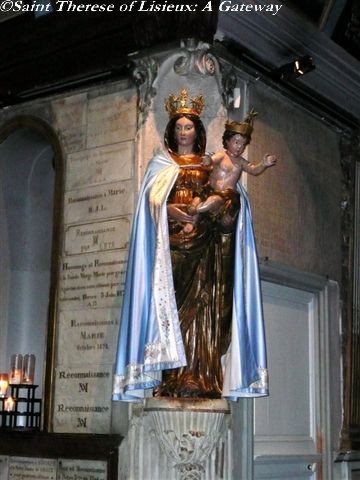 Statue of Our Lady of Grace in her chapel at Honfleur. Photo credit: Ann Hess
Statue of Our Lady of Grace in her chapel at Honfleur. Photo credit: Ann Hess
In June 1887, possibly on Saturday, June 18, Louis Martin took his three daughters, Leonie, Celine, and Therese, to visit an international maritime exhibit in Le Havre. They passed through the port of Honfleur and paused to pray at the Chapel of Our Lady of Grace, also called Our Lady of Consolation. At this mariners' chapel many missionaries and others who were leaving for the New World had come to pray to Our Lady for a safe crossing. The Martins are believed to have come here on other occasions.
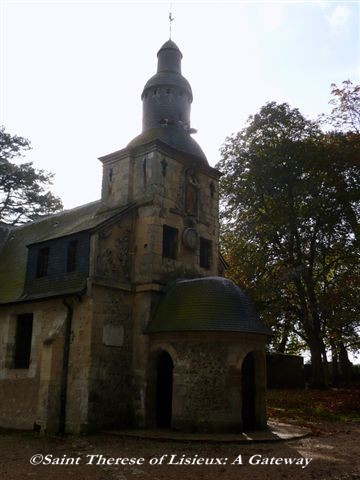 The chapel of Our Lady of Grace at Honfleur. Photo credit: Ann Hess
The chapel of Our Lady of Grace at Honfleur. Photo credit: Ann Hess
Therese, then 14, who on May 29 had received from her father permission to become a Carmelite, asked Our Lady to permit her to enter the Carmelite Monastery at Lisieux despite her youth.
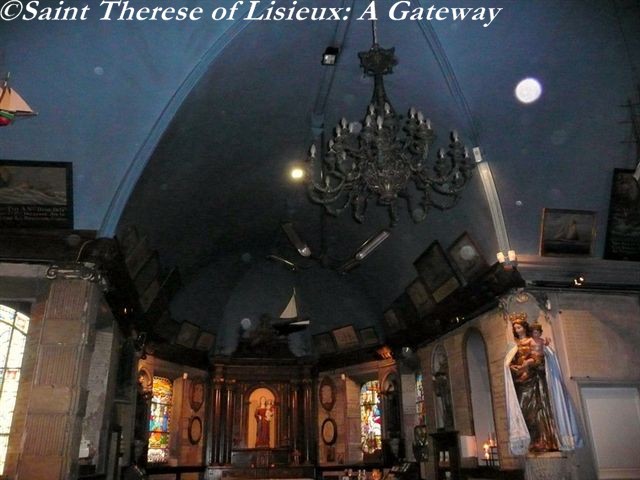 The main altar of the chapel of Our Lady of Grace at Honfleur. The statue before which Therese prayed is seen at right. Photo credit: Ann Hess
The main altar of the chapel of Our Lady of Grace at Honfleur. The statue before which Therese prayed is seen at right. Photo credit: Ann Hess
Leonie also prayed here for her vocation. She had made a six weeks' trial with the Poor Clares at Alencon the year before, and she would enter the Monastery of the Visitation at Caen in just a few weeks, on July 16, 1887. At this first trial with the Visitation, she remained for six months.
Fifty uears before Therese's visit, in 1837, two sisters, Athalie and Desiree Gosselin, had come with their priest-counselor, Fr. Nicolas Sauvage, to pray for the grace of being able to found the Carmelite monastery at Lisieux, the very monastery Therese later entered. A plaque in the chapel commemorates the visits of these three future Carmelites of Lisieux.
I had the privilege of visiting this chapel in 2008. It deeply moved my soul and my heart. I've never sensed in any other church or chapel the same atmosphere, and I recommend this little chapel to everyone who can make the pilgrimage. Whether or not we can go there physically, let's pray to Our Lady of Grace that, like Therese and Leonie, we may receive light to fulfill our own vocations. She will not refuse to hear us wherever we are.
The Abysses of Love and Mercy of the Heart of Jesus: St. Thérèse of Lisieux and the Sacred Heart - for the feast of the Sacred Heart
The Abysses of Love and Mercy of the Heart of Jesus:
St. Therese of Lisieux and the Sacred Heart
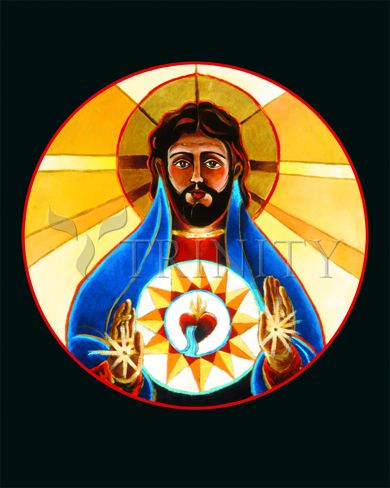 "Sacred Heart" icon by Michael O'Neill McGrath. OSFS. Available from Trinity Icon Stores.
"Sacred Heart" icon by Michael O'Neill McGrath. OSFS. Available from Trinity Icon Stores.
The devotion to the Sacred Heart in 19th-century France
 Basilica of the Sacred Heart at MontmartreThérèse Martin grew up in the Church of late 19th century France, in which the cult of the Sacred Heart was omnipresent, a cult of reparation shaped most recently by the humiliation of France during the Franco-Prussian war. Her family’s spiritual director, Father Almire Pichon, was called an apostle of the Sacred Heart. Her sister Marie took “of the Sacred Heart” as her religious name, and the Carmelite monastery Thérèse entered was dedicated to the Sacred Heart. In 1887 Thérèse participated in a pilgrimage to Rome intended to show the French church’s loyalty to the embattled Pope Leo XIII on his priestly jubilee. With the other pilgrims, before leaving Paris, Thérèse was consecrated to the Sacred Heart in the crypt of the unfinished Basilica of the Sacred Heart at Montmartre. (This text link leads to my detailed article about the events of that day). Later she sent her gold bracelet to form part of the large monstrance at the basilica. And, like all the pilgrims, she wore the badge of the Sacred Heart.
Basilica of the Sacred Heart at MontmartreThérèse Martin grew up in the Church of late 19th century France, in which the cult of the Sacred Heart was omnipresent, a cult of reparation shaped most recently by the humiliation of France during the Franco-Prussian war. Her family’s spiritual director, Father Almire Pichon, was called an apostle of the Sacred Heart. Her sister Marie took “of the Sacred Heart” as her religious name, and the Carmelite monastery Thérèse entered was dedicated to the Sacred Heart. In 1887 Thérèse participated in a pilgrimage to Rome intended to show the French church’s loyalty to the embattled Pope Leo XIII on his priestly jubilee. With the other pilgrims, before leaving Paris, Thérèse was consecrated to the Sacred Heart in the crypt of the unfinished Basilica of the Sacred Heart at Montmartre. (This text link leads to my detailed article about the events of that day). Later she sent her gold bracelet to form part of the large monstrance at the basilica. And, like all the pilgrims, she wore the badge of the Sacred Heart.
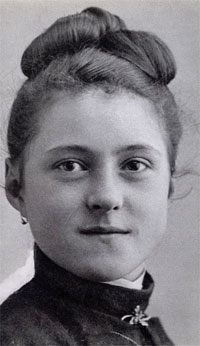 The Sacred Heart for Therese: "The Heart of my Spouse is mine alone"
The Sacred Heart for Therese: "The Heart of my Spouse is mine alone"
But Thérèse had no interest whatever in any cult of the Sacred Heart which was focused on making reparation for the outrages of sin. Nor did she relate to the Sacred Heart as a national symbol. The pilgrim Thérèse was seeking only Jesus. She appropriated the Heart of Jesus in an intensely personal and relational way. For Thérèse the Heart of Jesus is always for her, and it always seeks a response from her heart. At fifteen she called Jesus “Him whose heart beats in unison with my own.”[1] At seventeen she wrote to her sister Céline, who was at Paray-le-Monial with their sister Leonie for the second centenary of the death of then-Blessed Margaret Mary Alacoque, who received visions of the Sacred Heart:
Pray to the Sacred Heart; you know that I myself do not see the Sacred Heart as everybody else.[2] I think that the heart of my Spouse is mine alone, just as mine is His alone,[3] and I speak to Him then in the solitude of this delightful heart to heart, while waiting to contemplate Him one day face to face. . . [4]
June 1895: Merciful Love
In June 1895, the “year of the Sacred Heart” for Thérèse, she had a new experience of the heart of God:
I was thinking about the souls who offer themselves as victims of God’s Justice in order to turn away the punishments reserved to sinners, drawing them upon themselves. This offering seemed great and very generous to me, but I was far from feeling attracted to making it. From the depths of my heart, I cried out:
"O my God! Will Your Justice alone find souls willing to immolate themselves as victims? Does not Your Merciful Love need them too? . . . . On every side this love is unknown, rejected. . . . . . O my God! Is Your disdained Love going to remain closed up within Your Heart? It seems to me that if You were to find souls offering themselves as victims of holocaust to Your Love, You would consume them rapidly; it seems to me, too, that You would be happy not to hold back the waves of infinite tenderness within You.[5]
Thérèse experienced God not as outraged justice exacting atonement from her but as rejected love arousing her compassion and inviting her to be a channel of God’s infinite love to humanity.
1895: Poem "To The Sacred Heart of Jesus"
In her poem “To the Sacred Heart of Jesus,” written either in June or in October 1895 for her sister, Marie of the Sacred Heart, Thérèse returns to many of the themes of her “Offering of myself as a victim of Holocaust to Merciful Love.”[6] The editors of her poetry write:
“Thérèse does not linger over the symbol of Christ’s Heart wounded by the lance, which was so popular in her day. She goes straight to the reality: the loving Person of Jesus, his deep feelings, and the love that fills his Heart.”[7]
She speaks of the heart her own heart desires:
I need a heart burning with tenderness
Who will be my support forever,
Who loves everything in me, even my weakness…
And who never leaves me day or night.”[8]
She finds this heart in the humanity of Jesus and in the Eucharist:
You heard me, only Friend whom I love.
To ravish my heart, you became man.
You shed your blood, what a supreme mystery!...
And you still live for me on the Altar.
Deprived of palpable consolation, she can rest on the Sacred Heart:
If I cannot see the brilliance of your Face
Or hear your sweet voice,
O my God, I can live by your grace,
I can rest on your Sacred Heart!
The Heart is not a distant symbol to her: it is all her joy.
O Heart of Jesus, treasure of tenderness,
You Yourself are my happiness, my only hope.
You who knew how to charm my tender youth,
Stay near me till the last night.
She does not propitiate the Heart, but always locates herself inside it:
It’s in your ever-infinite goodness
That I want to lose myself, O Heart of Jesus!
The Heart of Jesus does not demand atonement; it simply burns with love. Faced with her human weakness and the justice of the law, Thérèse takes refuge in that heart, which not only protects her but also is itself her virtue (reminiscent of her offering of herself: “I beg You, O my God, to be Yourself my Sanctity!”[9]):
Ah! I know well all our righteousness
Is worthless in your sight.
To give value to my sacrifices,
I want to cast them into your Divine Heart.
I do not fear, my virtue is You!...
You did not find your angels without blemish.
In the midst of lightning you gave your law!...
I hide myself in your Sacred Heart, Jesus.
Thérèse’s confidence reaches its height in her daring prayer choosing the Heart of God as her purgatory and asking to go straight to the Heaven of that Heart:
To be able to gaze on your glory,
I know we have to pass through fire.
So I, for my purgatory,
Choose your burning love, O heart of my God!
On leaving this life, my exiled soul
Would like to make an act of pure love,
And then, flying away to Heaven, its Homeland,
Enter straightaway into your Heart.
In another poem she wrote in October 1895, she audaciously prays to love Jesus with His own heart:
Remember that on earth I want
To console you for the forgetfulness of sinners.
My only Love, grant my prayer.
Ah! give me a thousand hearts to love you.
But that is still too little, Jesus, Beauty Supreme.
Give me your divine Heart Itself to love you.[10]
Several months later she again appropriates the Heart of her Spouse “to love more tenderly.” She writes to her Visitandine sister Léonie:
Dear Sister, I love you a thousand times more tenderly than ordinary sisters love each other, for I can love you with the Heart of our celestial Spouse.[11]
Far from demanding reparation, the Heart of Jesus (“more than maternal”) repairs us. In 1896 Thérèse writes that this heart “restores innocence:”
O you who knew how to create the mother’s heart,
I find in you the tenderest of Fathers!
My only Love, Jesus, Eternal Word,
For me your heart is more than maternal.
***
Your heart that preserves and restores innocence
Won’t betray my trust![12]
Thérèse writes often of “resting” or “sleeping” on the heart of Jesus
And if sometimes Jesus sleeps,
You will rest beside Him.
His Divine Heart that always keeps vigil
Will serve as your sweet support.[13]
The little child . . . sleeps always on the Heart of the Great General. Close to this Heart, we learn courage, and especially confidence.[14]
June 1897: the Heart of Jesus and the heart of Mary Magdalene
Three months before her death, writing to Maurice Bellière, the seminarian who was her spiritual brother, Thérèse gives her most powerful witness to her experience of the Heart of Jesus:
When I see Magdalene walking up before the many guests, washing with her tears the feet of her adored Master, whom she is touching for the first time, I feel that her heart has understood the abysses of love and mercy of the Heart of Jesus, and, sinner though she is, this Heart of love was not only disposed to pardon her but to lavish on her the blessings of His divine intimacy, to lift her to the highest summits of contemplation.
Ah! dear little Brother, ever since I have been given the grace to understand also the love of the Heart of Jesus, I admit that it has expelled all fear from my heart. The remembrance of my faults humbles me, draws me never to depend on my strength which is only weakness, but this remembrance speaks to me of mercy and love still more.[15]
On July 17, 1897 she ends her last letter to Léonie, promising to be her sister’s messenger to the Sacred Heart:
You want me to pray in heaven to the Sacred Heart for you. Be sure that I shall not forget to deliver your messages to Him and to ask all that will be necessary for you to become a great saint.[16]
The next day Thérèse writes once more to Maurice Bellière about the heart of Jesus. For more than a century her message has echoed in the heart of humanity, as it echoes today:
Ah! how I would like to make you understand the tenderness of the Heart of Jesus, what He expects from you![17]
______________________________
[1] Excerpt from LT 67, letter from Thérèse to her aunt, Mme. Guerin, November 18, 1888. Letters of St. Thérèse of Lisieux, Volume I, 1877-1890, tr. John Clarke, O.C.D. Washington, D.C.: ICS Publications, 1982, p 478. The next three notes are drawn from that work.
[2] “Crowned with thorns, with a big cross set up in the center,” as Sister Marie of the Sacred Heart wrote to Celine on October 13, quoting P. Pichon.
[3] See Canticle of Canticles 2:16.
[4] Excerpt from LT 122, letter from Thérèse to Cèline, October 14, 1890. The second centenary of Blessed Margaret Mary’s death, October 17, 1890, attracted crowds to Paray-le-Monial. Letters of St. Thérèse of Lisieux, Volume II, 1890-1897, tr. John Clarke, O.C.D. Washington, D.C.: ICS Publications, 1988, pp. 709-710.
[5] Story of a Soul: The Autobiography of St. Thérèse of Lisieux, tr. John Clarke, O.C.D., 3rd edition. Washington, D.C.: ICS Publications, 1996, pp.180-181.
[6] This prayer is often called the “Act of Oblation to Merciful Love,” but Thérèse never called it that. She titled her manuscript "Offering of myself as a Victim of Holocaust to the Merciful Love of God."
[7] PN 23, Introductory notes to “To the Sacred Heart of Jesus,” June or October 1895, in The Poetry of Saint Therese of Lisieux, tr. Donald Kinney, O.C.D. Washington, D.C.: ICS Publications, 1996, p. 117.
[8] PN 23, “To the Sacred Heart of Jesus,” June or October 1895, in The Poetry of Saint Therese of Lisieux, ibid., pp. 117-120.
[9] Story of a Soul, op. cit., p. 276.
[10] PN 24, “Jesus, My Beloved, Remember!” October 21, 1895. The Poetry of Saint Therese of Lisieux, op. cit., p. 130.
[11] LT 186, from Thérèse to Léonie, April 11, 1896. Letters, Volume II, op. cit., p. 951.
[12] PN 36, “Jesus Alone,” August 15, 1896. The Poetry of Saint Therese of Lisieux, op. cit., p. 165.
[13] PN 13, “The Queen of Heaven to her Beloved Child Marie of the Holy Face,” December 25, 1894. The Poetry of Saint Therese of Lisieux, ibid., p. 78.
[14] LT 200, from Thérèse to Sister Marie of St. Joseph, end of October 1896? Letters, Volume II, op. cit., p. 1013.
[15] LT 247, from Thérèse to abbé Bellière, June 21, 1897. Letters, Volume II, ibid., p. 1133.
[16] LT 257, from Thérèse to Léonie, July 17, 1897. Letters, Volume II, ibid., p. 1149.
[17] LT 258, from Thérèse to abbé Bellière, July 18, 1897. Letters, Volume II, ibid., p. 1152.
Opening of diocesan process for sainthood for St. Therese's sister Leonie to be announced January 24, 2015 in France, according to the French press
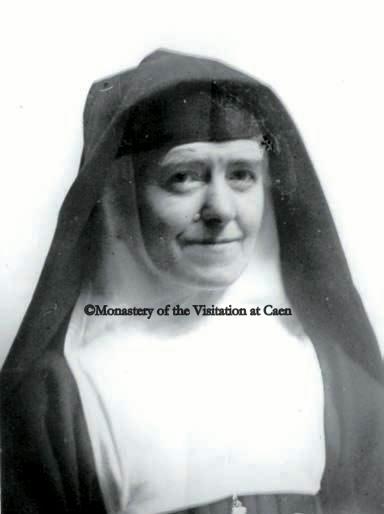
Please see this story about the announcement of the opening of the diocesan process at "Leonie Martin, Disciple and Sister of St. Therese of Lisieux."
The religious profession of St. Therese of Lisieux, September 8, 1890
Seotember 8, 1890, the feast of the Nativity of Mary, was the date set for St. Therese's religious profession. At that time nuns did not make temporary vows, so one's novitiate ended with the one set of permanent vows. According to the custom of Carmel, professions were usually made on a feast day of Mary, the patron of the Carmelite Order. Therese wrote "Mary's nativity! What a beautiful feast on which to become the spouse of Jesus!"1
On every September 8, the Carmelites of Lisieux exposed on the altar of the choir a small wax statuette representing the newborn Mary so that the nuns could venerate it there. The statue was called "La Bambina." Please click here to see the statue and here to see a close-up of the face of the statue. Have you ever seen another statue representing the infant Mary?
We may imagine Therese and her sisters venerating this statue on Therese's Profession day, the feast of the Nativity of Mary every year.
For Therese's dispositions in the days leading up to her Profession, please see the letters St. Therese wrote during her retreat for Profession, starting here.
On the morning of September 8, 1890, after Mass, the community escorted Therese, in procession, to the chapter room on the second floor, where the ceremony of professing vows was always held. This ceremony was a private one for Therese's Carmelite family. Click here to see a photograph of the chapter room decorated for a Profession. The young nun prostrated herself on the carpet for part of the ceremony. Over her heart Therese wore her "profession note," a little letter to Jesus expressing her desires. Please see both the English typescript and the handwritten note in French. During the ceremony the prioress placed on her head this crown of white roses:

This particular crown of roses had been worn by Mother Genevieve, a foundress of the Lisieux Carmel, for her jubilee, and Therese's sisters Pauline, Mother Agnes of Jesus, and Marie, Sister Marie of the Sacred Heart, also wore it for their professions. A few days before Therese's profession it was entrusted to Celine, who brought it to her father at the Bon Saveur mental hospital in Caen so that he might bless it.
During the ceremony Therese received her Profession crucifix from the prioress:
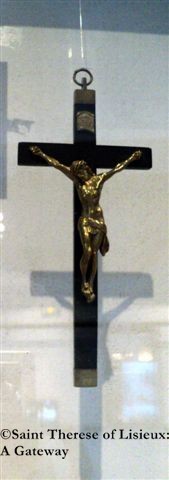
From Therese's own writings we know that she was "obliged" to ask for her father's cure that day, but would only pray "My God, I beg You, let it be Your will that Papa be cured." Much bolder was her prayer for Leonie: "Let Leonie become a Visitation nun, and, if she has no vocation, I beseech You to give her one; You cannot refuse me that." For how Therese remembered her profession later, see both the English typescript and the French handwritten manuscript of Therese's description of her Profession in her memoir, Story of a Soul.
For the two photos displayed here, I thank Adele Giambrone. For the linked photos, I thank the Web site of the archives of the Carmel of Lisieux. For the text, I thank the Washington Province of Discalced Carmelites, which owns the English text, and the Web site of the archives of the Carmel of Lisieux, which dislayed it online. Special thanks to the Internet Archive.
[Note that the new Web site of the Archives of the Carmel no longer displays the above-referenced translation].
1. Story of a Soul: The Autobiography of St. Therese of Lisieux, tr. John Clarke, O.C.D., Third Edition. Washington, D.C.: ICS Publications, 1996, p. 167.
The launch of the new Web site "Léonie Martin, Disciple and Sister of St. Thérèse of Lisieux"
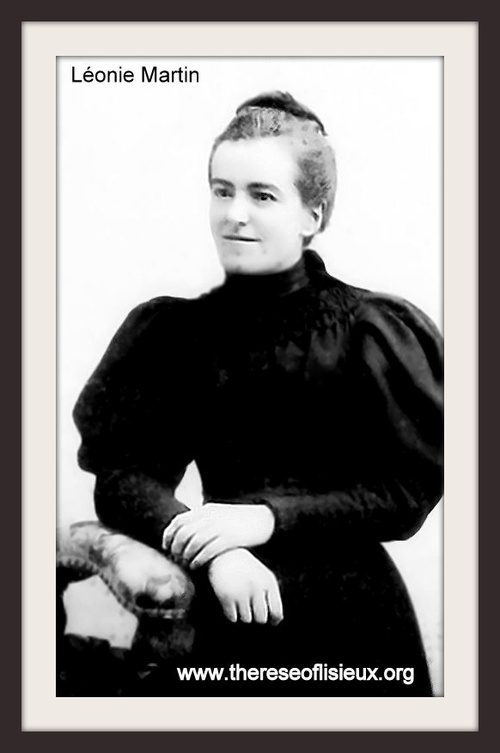
I am happy to announce the launch of my new Web site "Léonie Martin: Disciple and Sister of St. Thérèse of Lisieux." During her earthly life and for many years after her death, Léonie lived on the margin and in the shadows. Now Mgr Boulanger, the bishop of Bayeux and Lisieux, has granted the imprimatur for the prayer that she might be declared venerable; Father Sangalli, the vice-postulator for the cause of her parents, declared publicly that he hopes her cause for beatification and canonization can be opened soon, as so many letters request. More than seventy years after her death, Léonie is emerging into the light. Without destroying the hiddenness that was so much a part of her spirituality, and while still looking at her in the context of her relationships, I want to examine Léonie in her own right. I believe that, the more we study her, the more she will teach us about her pilgrimage on the way of confidence and love.
This new Web site contains all the information about Léonie that was on "Saint Therese of Lisieux: A Gateway." You can still access it from the link at left. It also has two jewels, never in English before, that are unique to it:
- My English translation of the new illustrated booklet "The Life of Léonie Martin," prepared in 2012 by Léonie's sisters at the Monastery of the Visitation of Caen. Copies of this booklet are offered to the pilgrims who come to pray at Leonie's tomb. Now this online copy offers English-speaking pilgrims the chance to make a "virtual pilgrimage" to Léonie's monastery and to her tomb. Please join me in thanking the present-day nuns of Léonie's community, who have been kindness itself to me, for their generous permission to translate and share this doorway to Léonie's world with her English-speaking disciples. May God bless them for it.
- With the very generous permission of Famille Chretienne, my Engish translation of the contemporary article "The hidden life of Léonie Martin, the rebel sister of St. Thérèse emerges from oblivion," which appeared in the June 8, 2013 issue. I thank Anne Slater for her help in translating this groundbreaking article, and I recommend it highly to those who want to learn about the rise of devotion to Léonie, the present state of her cause, and her influence on the lives of those who have received graces through her intercession.
To visit "Léonie Martin: Disciple and Sister of St. Thérèse of Lisieux" directly, please visit http://leoniemartin.org This is the first "daughter site" of "Saint Thérèse of Lisieux: A Gateway." Please God, it will not be the last.
Please join me in thanking my friend and benefactor Juan Marrero, a good friend and fervent devotee of Léonie, Thérèse, and Louis and Zélie, whose generous gift made Léonie's Web site possible. Please remember him gratefully in your prayers.